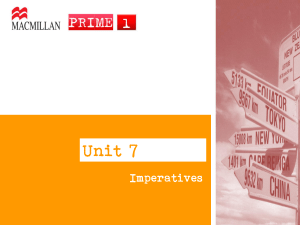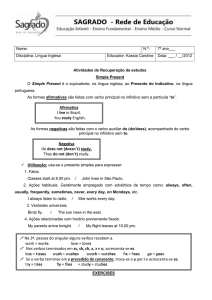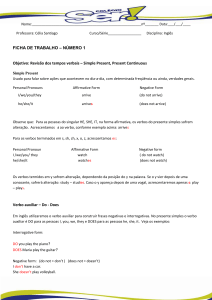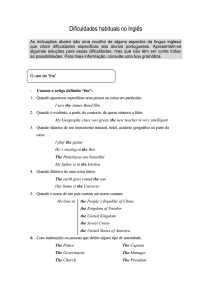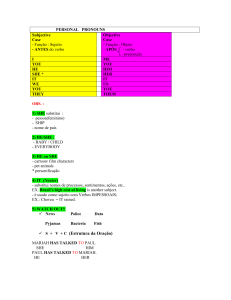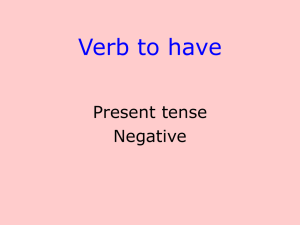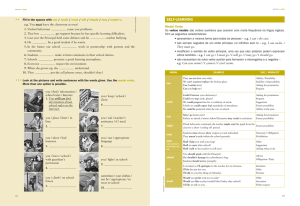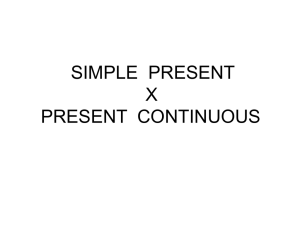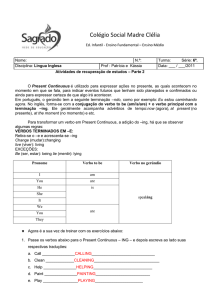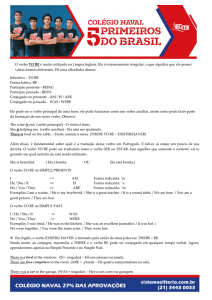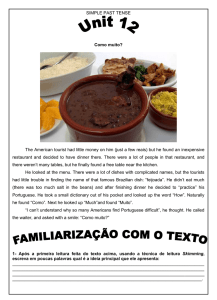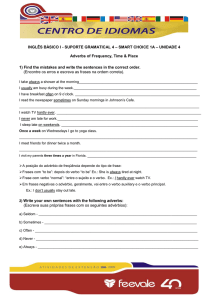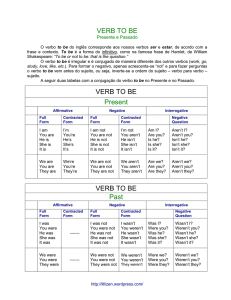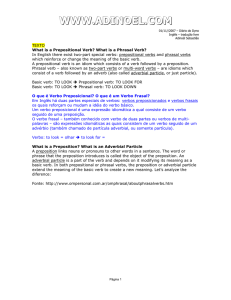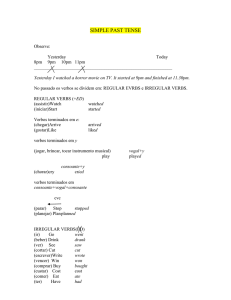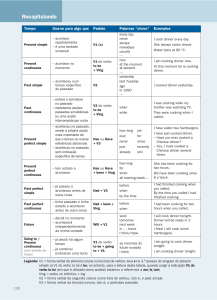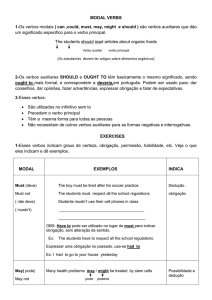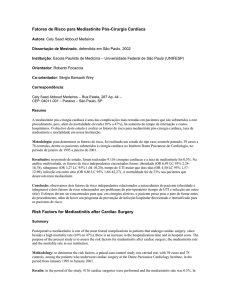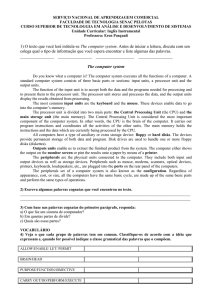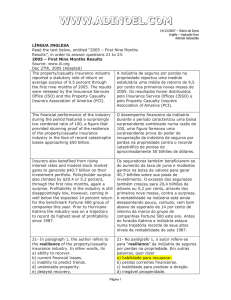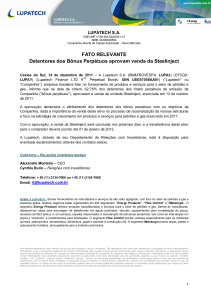Subject Pronouns
Propaganda
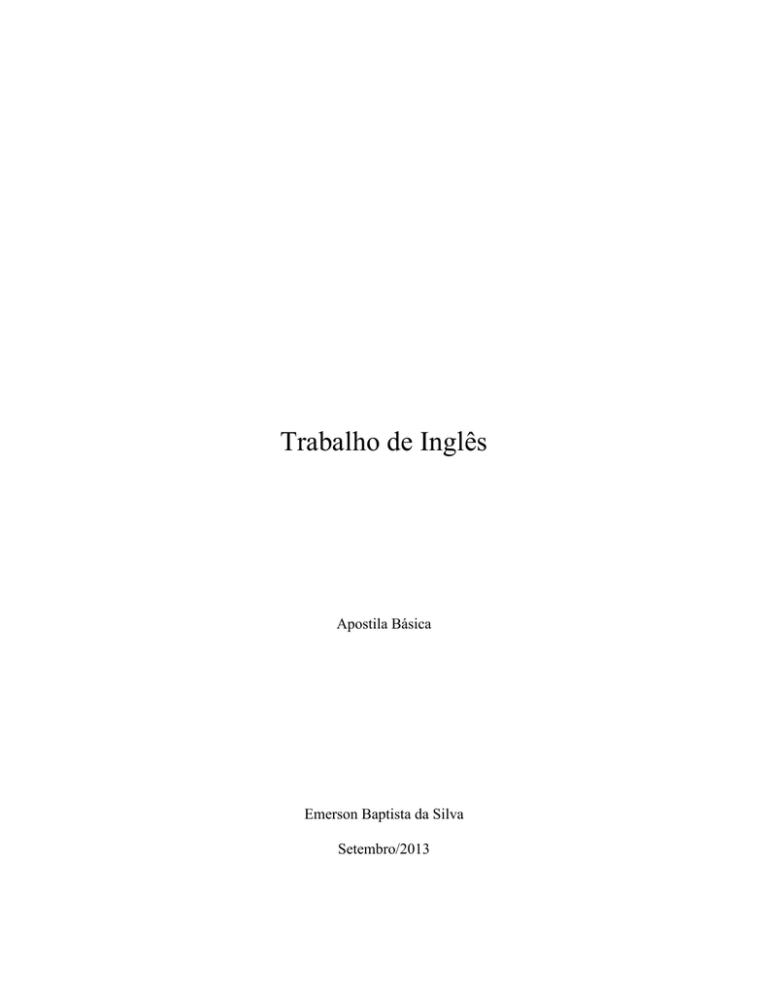
Trabalho de Inglês
Apostila Básica
Emerson Baptista da Silva
Setembro/2013
ADJETIVOS POSSESSIVOS
Pronomes Pessoais
I (eu)
you (você)
he (ele)
she (ela)
it (ele, ela - para animais)
we (nós)
you (vocês)
they (eles, elas)
Adjetivos Possessivos
my (meu, minha)
your (seu, sua)
his (dele)
her (dela)
its (dele, dela - para animais)
our (nosso, nossa)
your (seus, suas)
their (deles, delas)
O adjetivo possessivo sempre vem seguido de um substantivo.
Ex: my feet / your car / their house
Ex: His car is a Chevrolet.
Your office is big. / Her name is Regina. / His last name is Smith.
The lion (it) is in its cage. / Their house is very big.
O adjetivo possessivo se refere ao possuidor e não ao objeto possuído.
Ex: Mark has students.
Jerry is his student.
Silvia is his student.
‘His’ é usado tanto para o masculino quanto para o feminino, pois é referente a Mark (he).
ARTIGOS
a,an = artigo indefinido (um, uma). O artigo ‘a’ é usado antes de uma palavra que começa com uma
consoante.
Ex: I want a glass of milk.
Antes do ‘H’ pronunciado.
Ex: They have a house in New York.
‘An’ é usado antes de vogais.
Ex: She is an old lady.
Antes do ‘H’ não pronunciado
Ex: She's an honest person.
Os artigos ‘a, an’ não são usados no plural.
Ex: She has a friend. She has friends.
‘the’ = artigo definido (o, a, os, as), não varia no singular/plural.
Ex: This is the new centre park.
These are the projects we are working on.
‘The’ não muda no masculino/feminino.
Ex: This is the refrigerator that I want to have.
O artigo ‘the’ determina posição.
Ex: The car is on the right (side).
É usado para determinar o começo e o fim.
Ex: In the beginning I am shy, but I always make many friends in the end.
Para citar instituições:
Ex: the fire station
Não se usa ‘the’ antes de refeições.
Ex: He has breakfast at nine o'clock.
AUXILIARES - ‘CAN / COULD’
O verbo auxiliar ‘can’ indica a capacidade de fazer algo, quando é seguido de um verbo no infinitivo.
Ex: They can sing. É usado sem variação para todas as pessoas, inclusive na terceira pessoa do
singular.
Ex: She can dance.
A forma negativa de can é ‘cannot’, abreviada ‘can't’.
Ex: We can swim, but we can't play soccer. Na forma interrogativa, ‘can’ é colocado antes do sujeito.
Ex: Can Silvia play chess?
O passado de ‘can’ é ‘could’.
Ex: He could read when he was five years old. A forma negativa é ‘could not’ abreviada ‘couldn't’.
Ex: Ann couldn't come to class today because she was sick
Para pedir um favor usa-se ‘can you..?’ ou ‘could you..?’
Ex: Can you open the window, please?
‘Can you tell me..?’ é usado para fazer perguntas.
Ex: Can you tell me where the staff meeting is?
VERBOS AUXILIARES - ‘TO BE / DO’
Os verbos auxiliares ‘do/don't/does/doesn't’ formam o Presente Simples interrogativo e negativo.
‘Does/doesn't’ = é usado para a terceira pessoa do singular (he, she, it).
Presente Simples negativo:
I like soccer but I don't like basketball.
Ted doesn't speak Spanish.
Presente Simples interrogativo:
Do you like grapes?
Does she play a musical instrument?
O verbo auxiliar ‘to be’ (no presente) + o gerúndio do verbo principal = Presente Contínuo
Ex: I'm going to the beach.
O verbo auxiliar ‘to be’ (no presente) + ‘not’ + o gerúndio do verbo principal = Presente Contínuo
Negativo
Presente Contínuo negativo:
Ex: He is not driving fast.
Presente Contínuo interrogativo:
Are you listening to classical music
‘Did/didn't’ formam o Passado Simples interrogativo e negativo.
Passado Simples interrogativo:
Did they go to school on Friday?
Passado Simples negativo:
I didn't travel last summer.
CONJUNÇÕES
‘and’ = conjunção ‘e’
Ex: I don't speak Japanese and she doesn't speak English.
‘but’ = conjunção ‘mas, porém’
Ex: I watched the film but I didn't read the book.
‘or’ = conjunção ‘ou’
Ex: Are we going to the movies or to the theater?
‘because’ = conjunção ‘porque’
Ex: He decided to sleep early because he had a meeting on the next day.
EXPRESSÕES COM VERBOS AUXILIARES / QUESTION TAGS
‘Have you? / ‘are you’ / ‘don't you?’ = para expressar surpresa, espanto ou admiração.
Ex: I have thought about it a lot. Have you? What's your opinion?
I'm very sad today. Are You? What happened?
I don't care about the way I look. Don't you? So, why do you exercise so much?
Na ‘question tag’, a pessoa que pergunta pede uma confirmação. A ‘question tag’ é negativa quando a
sentença é afirmativa e vice-versa.
Ex: Mark is a good looking man, isn't he?
Ex: You speak Spanish, don't you?
She is a doctor, isn't she?
They don't have an appointment, do they?
HAVE / HAVE GOT
‘To Have / have got’ = expressa posse (ter)
Ex: They have many friends.
‘Has’ é usado na terceira pessoa do singular (he, she, it).
Ex: He has a lot of talent.
Na forma negativa e interrogativa, usa-se o auxiliar ‘do’.
Ex: Do they have many things to do?
He doesn't have a lot of problems.
‘Have got’ é a forma britânica do verbo (ter). Em inglês americano usa-se ‘have’.
Ex: They have many poems.
I have got many paintings.
Formas abreviadas:
I've got many secrets.
We 've got some musical instruments.
Forma interrogativa de ‘have got’:
Ex: Have they got a swimming pool?
Afirmativa: They have got a nice house.
Forma negativa:
Ex: He has not got a lot of problems.
We have not got a dog.
Forma abreviada negativa:
He hasn't got a lot of doubts.
They haven't got debts.
Respostas completas e curtas para ‘have’:
Ex: Do you have a sweater?
Yes, I have a sweater. / Yes, I have.
Para ‘have got’:
Have you got a tool kit?
Yes, I've got a tool kit. / Yes, I have.
Atenção:
he's = he is
he's = (he has) got
Ex: Is he a teacher? Yes, he's a teacher.
Has he got a computer? Yes, he's got a computer.
INFINITIVO / GERÚNDIO
Infinitivo = (to read, to write, to talk...).
Gerúndio = (reading, writing, talking...)
Usa-se o infinitivo após os verbos:
learn, hope, forget, need, refuse, want, try, offer, expect, promise, decide, plan.
Ex: She expects to learn a lot. They offered to help them.
Usa-se o gerúndio após os verbos:
finish, have, stop, love, hate, mind, enjoy, suggest.
Ex: I love travelling. We stopped smoking.
Em alguns casos, tanto o infinitivo quanto o gerúndio podem ser usados:
We like to work here. We like working here.
Alice prefers to travel by plane. Alice prefers travelling by plane.
Verbos que podem ser usados no infinitivo ou gerúndio:
like, start, continue, begin, prefer.
Após ‘would’, o verbo é colocado no infinitivo
Ex: I would like to go to the club.
Would they hate to live in an apartment?
PASSADO SIMPLES
‘Simple past’ = passado
Comparação entre ‘simple present’ e ‘simple past’
Simple Present:
I listen to music every day.
Simple past:
She played the violin yesterday afternoon.
O ‘Simple past’ regular é formado acrescentando-se -ed ao final do verbo.
Ex: talk - talked / work - worked / play - played
Quando o verbo regular termina em -e basta acrescentar o -d.
Ex: love - loved
Quando termina em -y precedido de consoante, substitui-se o -y por -ied.
Ex: study - studied
Esta regra não é usada quando o -y é precedido de vogal.
Ex: enjoy - enjoyed
Quando o verbo termina em uma consoante precedida por apenas uma vogal, dobra-se a consoante final
antes de se acrescentar -ed.
Ex: stop - stopped
O ‘simple past’ não varia de pessoa para pessoa.
Ex: I organized my schedule.
He wrote poems .
Exemplos de verbos irregulares:
Ex: drive - drove / do - did / have - had
I woke up late yesterday.
She took her kids home.
Para saber o ‘simple past’ de verbos irregulares é preciso consultar uma tabela específica. As tabelas de
verbos geralmente são da seguinte forma:
Infinitive
begin
Simple Past
began
Past Participle
begun
No ‘simple past’, o ‘infinitive’ corresponde à forma presente do verbo. Para passar da forma afirmativa
para a negativa no ‘simple past’, utiliza-se o auxiliar ‘did’ + ‘not’. Quando o verbo auxiliar está no ‘simple
past’ o verbo principal é colocado no infinitivo.
Ex: I played chess last week. / I did not play poker last week.
Esta regra também é válida para verbos irregulares.
Verbo ‘to do’ (fazer)
Respostas completas e curtas:
Did he do the job? / Yes, he did the job. / yes, he did.
No, he didn't do the job. / No, he didn't.
O ‘simple past’ do verbo ‘to be’ é:
I
you
he
she
it
was
were
was
was
was
we
you
they
were
were
were
Ex: I was tired.
He was busy.
Na forma interrogativa, inverte-se a posição do verbo com a do sujeito.
Was he handsome?
Was he late?
Respostas completas e curtas
Yes, he was handsome. / Yes, he was.
No, he wasn't late. / No, he wasn't.
Tabela do verbo ‘to be’ em sua forma negativa completa e abreviada:
I was not
You were not
he was not
she was not
it was not
we were not
you were not
they were not
I wasn't
You weren't
he wasn't
she wasn't
it wasn't
we weren't
you weren't
they weren't
PERGUNTAS COM PALAVRAS INICIADAS POR WH- / HOW
‘What’ = qual, que (quando não há alternativas definidas)
Ex: What is your name?
What kind of car is that?
‘Which’ = que, qual (quando há alternativas, para a resposta).
Ex: Which do you prefer? The black shirt or the blue one?
Quando as alternativas estão na sentença de modo indireto:
Which hotel did he stay at?
‘How’ = ‘como’:
How do you do that?
Com um adjetivo ou advérbio, ‘how’ indica quantidade ou intensidade:
How often do you go to parties?
How old is your grandfather?
How deep is this swimming pool?
‘Where’ = aonde
Ex: Where do you live?
‘Why’ = Por que (interrogativo)
Ex: Why are you so happy?
‘Because’ = ‘porque’ afirmativo, usado em respostas.
Ex: Because I got a good grade on the test.
‘Who’ = ‘quem’.
Ex: Who is your favorite singer?
‘Whose’ = ‘de quem’.
Ex: Whose car is this?
Whose pode vir isolado ou seguido de um substantivo:
Whose is this? It's mine.
Whose pen is this?
That pen is mine.
PLURAL DOS SUBSTANTIVOS
O plural da maioria dos substantivos é formado acrescentando-se -s.
Ex: a car - some cars / a cat - some cats / a friend - some friends
Os adjetivos não variam no plural:
a beautiful dress - some beautiful dresses
a big building - some big buildings
an intelligent student - some intelligent students
Quando o substantivo termina em -s / -sh / -ch / -x / -o, acrescenta-se -es:
a bus - some buses / a dish - some dishes / a match - some matches / a box - some boxes / a potato some potatoes
Quando o substantivo termina em -y, o ‘y’ é substituido por -ies:
a baby - some babies
Se o -y for precedido de vogal, basta acrescentar -s:
a day - some days
Se o substantivo terminar em -f ou -fe, estes são substituídos por -ves:
a shelf - some shelves / a knife - some knives
Plural de substantivos irregulares:
man - men / woman - women / child - children / foot - feet / tooth - teeth / mouse - mice / one sheep - ten
sheep / one fish - many fish / a person - some people
Alguns substantivos são sempre usados no plural:
(a pair of) scissors / (a pair of) glasses / (a pair of) pants / jeans / shorts
POSSESSIVO COM 'S
A forma ('s) serve para definir o possuidor, quando ele é uma pessoa. Porém, quando falamos de coisas
ou lugares usamos (of):
The roof of the house.
The capital of Italy.
Quando o substantivo que se refere ao proprietário termina em -s, acrescenta-se apenas o apóstrofe:
This is my relative's house.
This is my relatives' house.
Outros exemplos com substantivos terminados em -s:
The students' books are very interesting.
He is a great man because of his parents' love.
PRESENTE SIMPLES E CONTÍNUO
Ex: I write letters.
O ‘simple present’ -> expressa hábitos, coisas que acontecem freqüentemente
Ex: I like chocolate cake. / The Shopping Center opens at 10 o'clock.
Exemplos de ‘simple present’ + advérbios de freqüência:
Ex: always - sempre / never - nunca / often - frequentemente / sometimes - às vezes
Ex: He always travels on the weekend. / They never go to the park in the mornings. / I often do computer
work. She sometimes goes to the club.
Geralmente o advérbio de frequência vem antes do verbo. O verbo varia na terceira pessoa do singular
(he, she, it), acrescentando-se -s:
I
you
he
she
it
we
you
they
walk
walk
walks
walks
walks
walk
walk
walk
Exceções:
Se o verbo termina em -ch, -sh, -s, -o, acrescenta-se -es.
Ex: we watch - it watches / I wash - he washes / you pass - she passes / they do - she does
Se o verbo termina em -y, substituimos o -y por -ies.
Ex: we study - she studies
Mas se o verbo termina em -y, e antes dele vem uma vogal, basta acrescentar -s.
Ex: I enjoy - he enjoys
O verbo ‘to have’ é uma exceção:
I
you
he
she
it
we
you
they
have
have
has
has
has
have
have
have
Na forma negativa do ‘simple present’ se usa o auxiliar ‘do’ + o negativo ‘not’.
Ex: They do not like salad.
‘Do not’ = ‘don't’ (Abreviação)
Ex: I do not know the answer. I don't know the answer.
Na terceira pessoa do singular, o auxiliar ‘do’ varia; é ‘does’. Quando o auxiliar ‘does’ é usado, o verbo
principal fica no infinitivo.
Ex: She does not speak Japanese very well.
‘Does not’ = ‘doesn't’ (Abreviação)
Ex: He doesn't like to read. / This TV always breaks. It doesn't work well.
O verbo ‘to do’ significa (fazer) quando é o verbo principal. Ele pode aparecer duas vezes na mesma
sentença, como verbo auxiliar e como verbo principal.
They do their job every day.
They don't do the same thing every year.
She does many things at the same time.
She doesn't do one thing at a time.
Na forma interrogativa do ‘simple present’ usa-se o auxiliar ‘do’ no começo da sentença.
Ex: Do they like to go to the movies?
Does she always paint on Wednesdays?
O ‘present continuous’ é formado pelo verbo ‘to be’ no presente (infinitivo) + gerúndio do verbo principal.
Ex: I'm writing in English.
O gerúndio é formado acrescentando-se -ing ao final do verbo.
Infinitivo
laugh
Gerúndio
(em inglês)
laughing
Gerúndio
(em português)
rindo
Exemplo:
He is laughing. They are smiling.
O ‘present continuous’ = descreve ações que estão acontecendo no momento em que se fala. Forma
afirmativa abreviada:
He's laughing. They're smiling.
Forma negativa abreviada:
He's not/he isn't laughing. / They're not/they aren't smiling.
Grafia
- Quando o verbo termina em -e, retira-se o -e final e se acrescenta -ing.
Ex: smoke - smoking
Quando o verbo termina em consoante precedida de uma vogal, dobra-se a consoante final:
run - running
Exceções:
lie - lying / die - dying
Na forma interrogativa, inverte-se a posição do verbo auxiliar ‘to be’:
We are studying. / Are we studying? / They are going home. / Are they going home?
Respostas completas e curtas:
Yes, we are studying. / Yes, we are. / No, we are not/we aren't studying.
‘What, where, when, why’ são colocados no começo da sentença, em perguntas. Exemplo:
Why are you asking me that?
Resposta:
Because I'm interested.
Alguns verbos não são usados no ‘present continuous’:
want - querer / need - precisar / mean - significar / forget - esquecer / like - gostar / prefer - preferir /
understand - entender / love - amar / depend - depender / believe - acreditar / hate - odiar / know - saberconhecer / remember - lembrar
O gerúndio é usado após os verbos:
finish - terminar / stop - parar / mind - importar-se com / suggest - sugerir / hate - odiar / love - amar /
enjoy - desfrutar
Ex: Do you mind turning the radio down, please? (Você se importa em abaixar o volume do rádio por
favor?)
PRONOMES
Subject Pronouns
Pronome é a palavra que substitui ou determina o nome. Classificam-se em pessoais, possessivos,
demonstrativos, indefinidos, interrogativos e relativos. Os pronomes pessoais retos são usados como sujeito da
oração, ocupando a posição antes do verbo em inglês. São eles: I (eu), you(você, tu), he (ele), she (ela), it(ele,
ela), we(nós), they(eles):
I am a teacher.
You are Brazilian.
He is a doctor.
She likes him.
It is blue.
We are hungry.
They are intelligent.
São sempre expressos, exceto em frases imperativas. I é sempre escrito com letra maiúscula e o pronome
neutro it é usado:
a)
Para coisa ou animal quando não há afetividade: The dog is beautiful. It is white.
b)
Para expressar tempo e medida: It’s ten o’clock. – It’s 30 miles to London.
Sua colocação acontece no início da frase
Os pronomes pessoais são:
I
you
he
she
eu
tu, você
ele
ela
ele, ela,
(neutro)
nós
vós, vocês
eles, elas
it
we
you
they
‘You’ é usado no singular e no plural. O verbo ‘to be’ = ser ou estar. ‘Simple present’ do verbo ‘to be’:
I am
you are
he is
she is
it is
we are
you are
they are
eu sou/estou
tu és/estás
ele é/está
ela é/está
ele, ela (neutro) é/está
nós somos/estamos
vós sois/estais
eles são/estão
I am
you are
he is
she is
it is
we are
you are
they are
I'm
you're
he's
she's
it's
we're
you're
they're
Ex: I am a teacher.
He is a doctor.
She is at home.
We are together.
Forma abreviada:
Ex: I'm here.
You're there.
They're friends.
Formas negativas completas e abreviadas:
Forma Completa
I am not
you are not
Abreviada
I'm not
you're not
he is not
she is not
it is not
we are not
you are not
they are not
he's not
she's not
it's not
we're not
you're not
they're not
Ex: They're not travelling.
She's not Spanish.
O pronome ‘I’ é sempre escrito com letra maiúscula. O plural de ‘he’ e ‘she’ é ‘they’. O pronome neutro ‘it’
é usado para referir-se a coisas, animais, fenômenos da natureza e seres inanimados. O plural de ‘it’ é
‘they’.
Os pronomes demonstrativos são: ‘this, that, these, those’.
‘This’ = este, esta, isto.
‘This’ é usado quando o objeto está próximo da pessoa que fala. O plural de ‘this’ é ‘these’.
‘That’ = aquele, aquela, aquilo.
A forma abreviada de ‘that is’ = ‘that's’.
Usa-se ‘that’ quando o objeto está longe da pessoa que fala. O plural de ‘that’ é ‘those’.
Pronomes pessoais e pronomes objeto:
Pronomes
Pessoais
I (eu)
you (você)
he (ele)
she (ela)
it (ele,ela neutro)
we (nós)
you (vós)
they (eles,elas)
Pronomes
objeto
me (me, mim, comigo)
you (te, ti, contigo)
him (o, lhe, ele)
her (a, lhe, ela)
it (o/a, lhe, ele/ela)
us (nos, conosco)
you (vos, convosco)
them (os/as, lhes, eles/elas)
Usa-se ‘it’ para objetos.
‘Them’ é usado no plural, para pessoas e coisas.
Tabela dos pronomes possessivos e adjetivos possessivos:
Adjetivos Possessivos
my
your
his
her
Pronomes
Possessivos
mine
yours
his
hers
Tradução
meu(s), minha(s)
teu(s), tua(s)
seu(s), sua(s)
seu(s), sua(s)
its
our
your
their
its
ours
yours
theirs
seu(s), sua(s) neutro
nosso(s), nossa(s)
vosso(s), vossa(s)
seu(s), sua(s)
Os adjetivos possessivos são seguidos de substantivo.
Os pronomes possessivos não são seguidos de substantivo:
Os possessivos concordam com o possuidor:
Os pronomes reflexivos = para falar de uma ação que recai sobre o próprio agente.
Tabela dos pronomes reflexivos:
Pronomes
Pessoais
I
you
she
it
we
you
they
Pronomes Reflexivos
myself (me; eu mesmo)
yourself (te; tu mesmo)
herself (se; ela mesma)
itself (se; ele/ela mesmo(a) neutro)
ourselves (nos; nós mesmos)
yourselves (vos; vós mesmos)
themselves (se; eles/elas mesmos(as))
‘Yourself’ = (singular), ‘yourselves’ = (plural).
A expressão ‘by yourself / myself / ourselves...’ = sozinho(s).
diferença entre estes dois exemplos:
We looked at ourselves in the mirror.
We looked at each other.
SUBSTANTIVOS CONTÁVEIS E INCONTÁVEIS
O artigo indefinido ‘a,an’ vem antes dos substantivos contáveis, no singular.
Ex: a boy.
Quando um substantivo contável está no plural, pode ser precedido por ‘some’ = ‘alguns, algumas’.
Ex: I have some pictures.
Os substantivos incontáveis não são usados no plural. Eles podem ser precedidos por ‘some’ = ‘algum,
alguma, um pouco de’.
Ex: He needs some help.
‘Some’ aparece em sentenças afirmativas, no singular e no plural:
There is some cheese in the larder.
There are some children playing in the garden.
Usa-se ‘any’ em sentenças negativas:
There isn't any milk!
There aren't any cars parked in the garage.
Usa-se ‘any’ em perguntas:
Are there any games for us to play, on the computer?
Is there any way to make this easier? Exemplos com ‘some’ e ‘any’:
‘Some’ é usado em perguntas quando estamos oferecendo alguma coisa:
Would you like some tea?
Alguns substantivos podem ser contáveis e incontáveis:
a cake = um bolo
some cakes = alguns bolos
some cake = um pouco de bolo
Exemplos de substantivos incontáveis:
bread, weather, information, advice, hair, furniture, paper, news.
‘A lot’, ‘much’ e ‘many’ são usados para relatar quantidades.
‘Much’ = muito, é usado com substantivos incontáveis.
Ex: They don't have much food.
‘Many’ = muitos, muitas. É usado com substantivos contáveis.
Ex: There are many movie theaters in town.
‘A lot of’ é usado no singular/plural, com substantivos contáveis ou incontáveis, substituindo ‘much’ ou
‘many’.
Ex: They don't have much patience.
They don't have a lot of patience.
There are many people in São Paulo.
There are a lot of people in São Paulo.
THERE IS / THERE ARE
There is / there are = haver, existir
Ex: There is a man standing next to the bus.
There are many people who like coming here.
There is a lot of furniture to be sold.
‘There is’ = ‘there's’ (Abreviação)
Ex: There's not much to say about this.
O plural de ‘there is’ é ‘there are’.
Na forma interrogativa o verbo auxiliar ‘To be’ fica no início da sentença.
Is there someone here to answer the phone?
Are there many ways of going to the airport from here?
Observe a diferença entre ‘there is’, there are’, ‘it is’, ‘they are’:
There is a person in the room. It is Jerry. (Há uma pessoa na sala. É Jerry.)
There are many people in the living room. They are engineers. (Há muitas pessoas na sala de estar. Eles
são engenheiros.)
WOULD YOU LIKE..?
Usa-se ‘would you like...’ para oferecer alguma coisa.
Ex: Would you like a cup of tea? = Do you want a cup of tea?
Para fazer um convite:
Ex: Would you like to go to the movies?
Usa-se ‘I would like...’ = ‘I'd like...’ (Abreviação), para pedir alguma coisa.
Ex: I would like to go out tonight. = I'd like to go out tonight.
Observe a diferença:
I like chocolate.
I would like some chocolate.
Do you like classical music?
Would you like to listen to some classical music.
Noun: substantivo = palavra com que se designa um ser ou objeto = house, door, car, sky, water
Adjective: adjetivo = palavra que qualifica o substantivo a que está ligado: blue, wonderful, hot
Verb: verbo = palavra que designa os processos, o estado, a ação, os fenômenos: to rain, to go, to be, to
pretend, to run
Preposition: preposição = partícula que estabelece a relação entre dois termos da frase: in, at, on, with, for,
through
Adverb: advérbio = palavra que indica tempo, lugar, quantidade: here, there, yesterday, very
Conjunction: conjunção = palavra que liga termos ou orações: who, that, which.
Fonte: Internet
